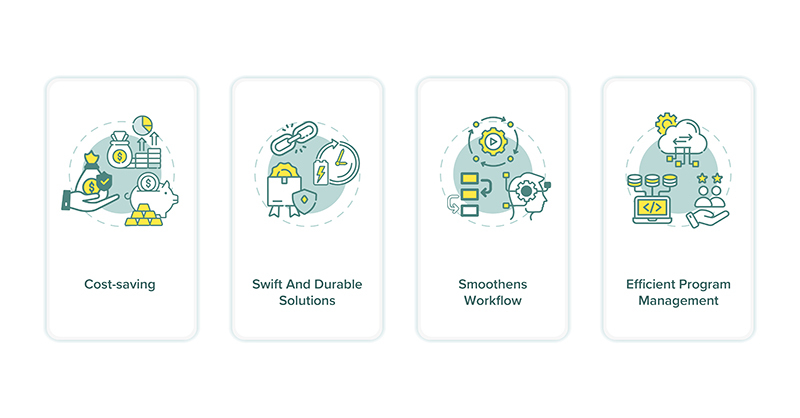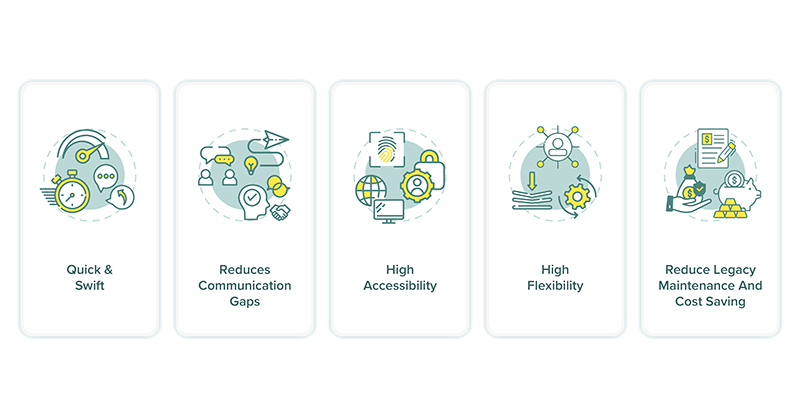Low-code/ No-code app development changed the coding landscape from its traditional approach, paving the way for quicker and more efficient applications delivered for performance.
Introduction
Digital transformation has become a buzzword that comes across more often in recent times, with companies across industries seeking ways to modernize their processes and improve efficiency.
Low-code and no-code platforms have emerged as key tools in this effort, allowing businesses to create custom applications without requiring extensive coding expertise. By reducing the barriers to entry for software development, these platforms are helping to accelerate digital transformation initiatives and bring new ideas to life faster than ever before.
Building Applications Visually With Low-code & No-code

One of the key features of Low-code and No-code platforms is the ability to build applications visually using drag-and-drop tools and pre-built modules.
This approach to software development allows non-technical users to participate in the process, drastically reducing the time and cost required to create custom applications.
By eliminating the need for extensive coding knowledge, Low-code and No-code platforms are helping to democratize software development and unleash the potential of digital transformation for businesses of all sizes.
As the capabilities of these platforms continue to evolve, we can see even more creative solutions emerge that drive business growth and success and transcend the boundaries of traditional coding & application development.
The Difference Between Low-code & No-code
Before diving deep into the domain of Low-code & No-code, it's essential to understand the difference between them.
Low-code platforms provide a visual interface for developers to create applications quickly, using pre-built modules and drag-and-drop tools; while back-end and internal workflows are major components of the Low-code platform, the need for codes still prevail when dealing with business rules and interaction between two fields.
Hence, people with no coding experience might find it challenging to work with Low-code platforms. In contrast, people with coding experience would find it easy to work with such platforms and can leverage drag & drop methods along with coding to create applications that are more efficient and productive.
On the other hand, no-code platforms require no coding and can be used by non-technical users to develop simple applications. While both have pros and cons, they are instrumental tools for digital transformation.
What Do Low-code & No-code Mean for Enterprises?
For enterprises, the use of Low-code & No-code platforms can mean a lot more than we think; these drag & drop platforms pave the way for faster development and reduce costs & resources, which can directly help organizations quickly create custom software solutions that complete the evolving business needs and provide a better experience.
One of the main attractions of the Low-code/No-code platforms is the immense flexibility followed by the vast customization options that allow enterprises to work on and create software & applications tailored to complete the project's needs and all the specific requirements.
Also, involving non-technical developers directly decreases the burden on technical developers and other involved IT departments, accelerating the time-to-market for new applications.
To achieve successful digital transformation, Low-code/No-code platforms need a consistent, simple, and scalable app governance process in addition to app development.
Since scaling an enterprise app corporate-wide without extensive customization and expense can be difficult when governance varies by platform.
However, in an efficient environment, it is necessary to note that sometimes the cost of using Low-code platforms can exceed the expected budgets, which include limited support to process workflow that will directly prevent the application's ability to scale to the scale of an enterprise.
Also, as cloud-native environments continue to develop, Low-code/No-code platforms improve to better support and scale for larger enterprise deployments, allowing for in-depth governance to support all cross-functional teams of the business and making enterprises choose these platforms for the long run.
Benefits of Low-code

Cost-saving: Platforms with minimal code levels are less expensive and require less deployment time. As the platform does not require a lot of code, it will be simple for a non-developer to create applications; all they need is basic coding knowledge.
Swift and durable solutions: Maintaining legacy systems is one of the significant difficulties today. In addition to providing the same advantages, such as quicker development, durable solutions, and the capacity to adapt to new requirements swiftly, Low-code platforms can integrate legacy mainframe systems.
Smoothens workflow: The creation of Low-code applications has lowered the barrier to innovation. Now, individuals without coding expertise can produce digital products. Moreover, this has quickened the development cycle since tasks can be completed within minutes instead of weeks, resulting in a more streamlined process and workflow.
Efficient program management: Low-code development helps to reduce the burden of program maintenance by eliminating the tedious work involved in daily development.
This approach results in fewer integration issues and faults since the components are pretested, standardized, and readily available. With Low-code development, developers can focus on creative tasks that generate more commercial value, as they spend less time on program maintenance.
Benefits of No-code

Quick and swift: No-code makes it possible to construct apps quickly in a fraction of the time compared to conventional or Low-code methods. It makes the transition from a concept to a usable application simple by using a visual interface with a wealth of capability.
Reduces communication gaps: No-code app development reduces communication gaps between IT teams and business executives. This is made possible through the use of a visual method, enabling a clear and transparent depiction of ideas. As a result, IT teams, business analysts, and engineers can collaborate more effectively across teams.
Highly accessible: Traditional app development architecture can lead to IT work bottlenecks that limit work to people with specific capabilities. However, no-code enables people working in business teams to offer ideas as it can transfer large, complex projects and break them into smaller ones. There are fewer project backlogs since everybody can participate in the entire development process, including individuals who cannot code.
Highly flexible: No-code employs a drag-and-drop interface instead of traditional code and data models. In the past, app developers had to describe each entity from scratch, which resulted in lengthy startup times and labor-intensive processes later on.
No-code enables a quicker, more logical data structure because your data is saved on a JSON document rather than a data model. With no-code platforms, you can start constructing immediately and adapt as you go, rebuilding or redirecting as necessary.
Reduces legacy maintenance and cost-saving: Every time a change is made, legacy code requires continual maintenance and updating. A company's bottom line may frequently suffer due to the requirement to engage specialized engineers to maintain the old code.
However, maintaining old code is unnecessary when using no-code development to create customized apps. This will lead to quick turnaround times, lower costs, and less strain on the bandwidth of an IT staff.
How did Dimiour Leverage the Power of Low-code/No-code?
Client onboarding: Our Low-code/No-code technology allows for a quicker client onboarding process, ensuring compliance with regulatory requirements and account setup, automating due diligence, and establishing a solid relationship with the client's satisfaction.
We were also able to create a better client-servicing environment to standardize and automate institutional and retail client account servicing, along with marketplace automation for product recommendations & real-time pricing and operation automation for the automation of business workflows supporting disparate systems.
How Can We Help?
At Dimiour, we aim to establish an industry-leading platform for Low-code & No-code application development for sectors that embrace digital transformation at their core.


